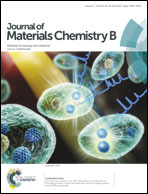Cryotemplation for the rapid fabrication of porous, patternable photopolymerized hydrogels†
Abstract
Hydrogels, which have become a central component of numerous strategies in regenerative medicine, have recently been designed to include pores as a means to facilitate cell ingrowth and facilitate transport. Herein, we present the formation of macro-porous hydrogels by a novel fabrication method termed cryotemplated photopolymerization. In contrast to chemically-induced cryogelation, our cryotemplation method separates the creation of pores from the crosslinking of the polymer, which allows templating of hydrogels using both porogens and light. This method allows separately frozen pieces to be joined during the photopolymerization, without the use of a mold, to form complex architectures. The size of the pores in the hydrogels could be controlled by multiple methods, thus providing a versatile platform for numerous tissue engineering applications. Additionally, these hydrogels were capable of functionalization with peptides using techniques that did not interfere with gelation. Furthermore, porous hydrogels could be formed under conditions suitable for cell freezing thereby allowing for cell encapsulation. These studies characterize a hydrogel fabrication strategy that enables the creation of porous scaffolds in complex architectures, while retaining the potential to chemically functionalize the hydrogels.


 Please wait while we load your content...
Please wait while we load your content...